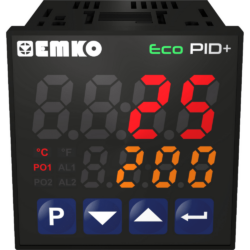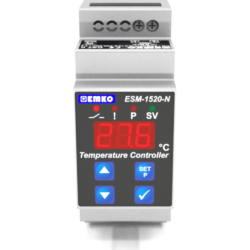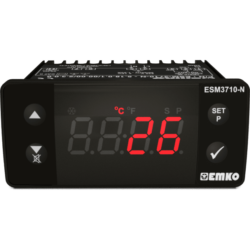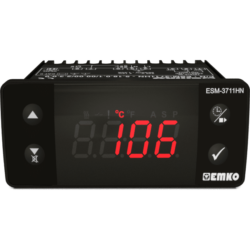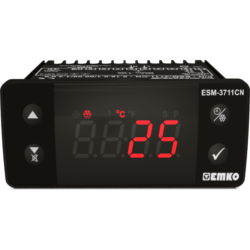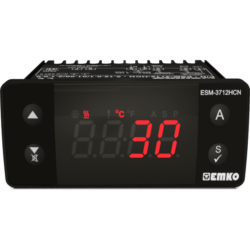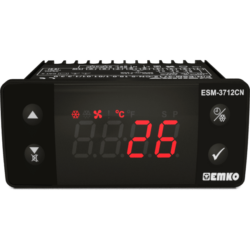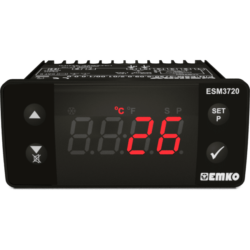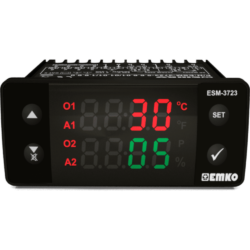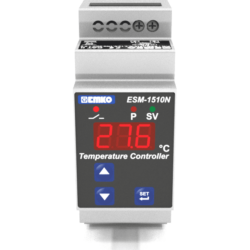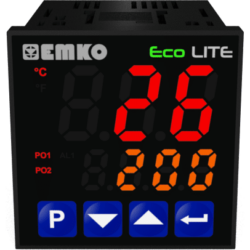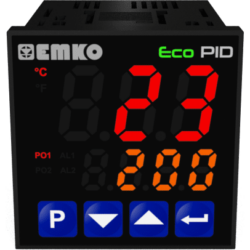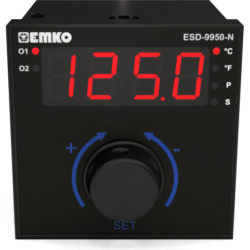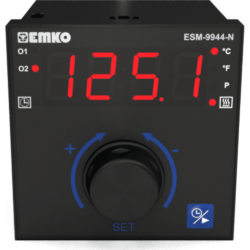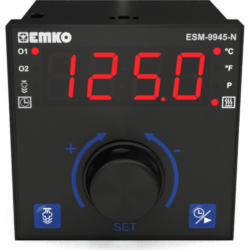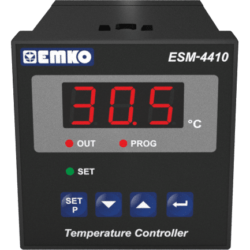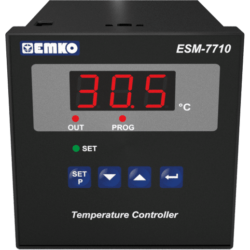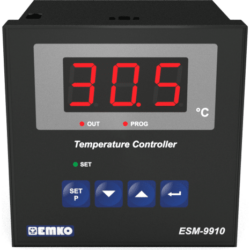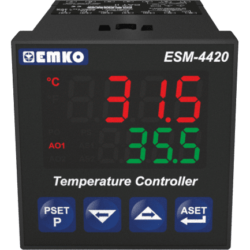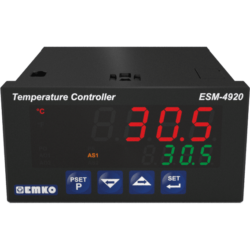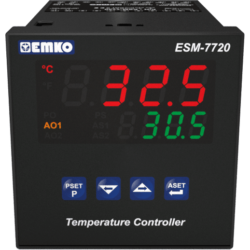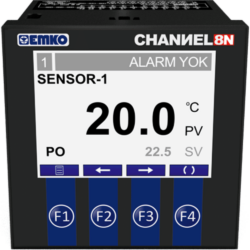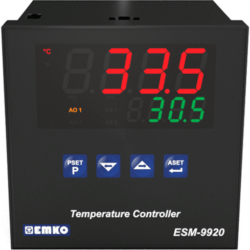Temperature controller
Product type
Function
Sensor input
-
EMKO ecoPID+ compact 4-digit PID temperature controller with heating and cooling function
- from 81,68 € plus VAT.
-
excl. VAT
-
EMKO ESM-1520-N PID and 2-point temperature controller with heating and cooling function for DIN rail mounting
- from 57,84 € plus VAT.
-
excl. VAT
-
EMKO ESM-3710-N 2-point temperature controller with heating and cooling function
- from 51,75 € plus VAT.
-
excl. VAT
-
EMKO ESM-3711-HN 2-point heating controller with timer and buzzer
- from 54,29 € plus VAT.
-
excl. VAT
-
EMKO ESM-3711-CN 2-point cooling controller with timer and buzzer
- from 51,75 € plus VAT.
-
excl. VAT
-
EMKO ESM-3712-HCN 2-point temperature controller with heating or cooling function and two outputs
- from 58,85 € plus VAT.
-
excl. VAT
-
EMKO ESM-3712-CN 2-point cooling controller with defrost function, timer and buzzer
- from 54,79 € plus VAT.
-
excl. VAT
-
EMKO ESM-3720 PID and 2-point temperature controller with heating and cooling function
- from 56,82 € plus VAT.
-
excl. VAT
-
EMKO ESM-3723 Dual temperature and humidity controller with 4 outputs ideal for climate control
- from 81,68 € plus VAT.
-
excl. VAT
-
EMKO ESM-1510-N 2-point temperature controller with heating and cooling function for top-hat rail mounting
- from 53,78 € plus VAT.
-
excl. VAT
-
EMKO ecoLITE compact 2-point temperature controller with heating and cooling function
- from 76,10 € plus VAT.
-
excl. VAT
-
EMKO ecoPID compact PID temperature controller with heating and cooling function
- from 81,68 € plus VAT.
-
excl. VAT
-
EMKO ESD-9950-N PID temperature controller with universal sensor input, rotary control and 2 outputs
- from 114,66 € plus VAT.
-
excl. VAT
-
EMKO ESM-9944-N PID oven control with universal sensor input, rotary control, timer and 2 outputs
- from 115,17 € plus VAT.
-
excl. VAT
-
EMKO ESM-9945-N PID oven control with universal sensor input, rotary control, timer and 3 outputs
- from 118,21 € plus VAT.
-
excl. VAT
-
EMKO ESM-4410 2-point controller for temperature sensors with heating and cooling function and extension module system
- from 61,39 € plus VAT.
-
excl. VAT
-
EMKO ESM-7710 2-point temperature controller with heating and cooling function and extension module system
- from 74,07 € plus VAT.
-
excl. VAT
-
EMKO ESM-9910 2-point controller for temperature sensors with heating and cooling function and extension module system
- from 81,18 € plus VAT.
-
excl. VAT
-
EMKO ESM-4420 PID temperature controller with heating and cooling function and 3 outputs
- from 89,80 € plus VAT.
-
excl. VAT
-
EMKO ESM-4920 PID temperature controller with heating and cooling function and 3 outputs
- from 109,08 € plus VAT.
-
excl. VAT
-
EMKO ESM-7720 PID temperature controller with heating and cooling function and 3 outputs
- from 100,46 € plus VAT.
-
excl. VAT
-
EMKO CHANNEL8-N Multi-channel temperature display for Pt100 resistance thermometers with alarm outputs
- from 579,06 € plus VAT.
-
excl. VAT
-
EMKO ESM-9920 PID temperature controller with heating and cooling function and 3 outputs
- from 102,99 € plus VAT.
-
excl. VAT
What are temperature controllers and where are they used?
Temperature controllers are devices that monitor and control the temperature of a system to keep it at a desired level. They usually work with temperature sensors that measure the current temperature and a control algorithm that decides whether and how much heating or cooling power needs to be supplied to reach the target temperature.
Temperature controllers are used in many applications, including
1. heating, ventilation and air conditioning (HVAC) systems: they ensure that the room temperature remains comfortable by adjusting the heating or cooling output.
2. industrial processes: In manufacturing and process industries, temperature controllers are used to maintain a constant temperature in reactors, ovens or other equipment, which is crucial for the quality and safety of products.
3. household appliances: In appliances such as refrigerators, ovens and dishwashers, they regulate the temperature to ensure optimum operating conditions.
4. medical applications: In medical devices, such as incubators or heating cabinets, they ensure that the temperature for storing samples or treating patients remains constant.
5. automotive technology: you control the engine temperature and air conditioning to optimise comfort and efficiency.
Overall, temperature controllers are important for maintaining stable conditions in many technical and everyday applications.
Precise temperature control for your industrial applications - our industrial temperature controllers!
Optimise your heating and cooling processes with our state-of-the-art industrial temperature controllers! Whether in ovens, refrigerated cabinets or other heating and cooling applications - our controllers provide you with the reliable temperature control you need for efficient production.
Why our industrial temperature controllers?
- Precise control: Our temperature controllers guarantee precise and stable temperature control, which is crucial for the quality of your products. Avoid temperature fluctuations and ensure the optimum performance of your systems.
- Versatile application: Whether in the food industry, chemicals or pharmaceuticals - our controllers are suitable for a wide range of applications and adapt flexibly to your requirements.
- Energy efficiency: By intelligently controlling the temperature, our products help to minimise energy consumption and reduce operating costs. Benefit from a sustainable solution that makes both economic and ecological sense.
- Ease of use: Our temperature controllers are easy to install and intuitive to operate. With clear displays and a user-friendly interface, you have control over your processes at all times.
Areas of application
- Ovens: Ensure even heat distribution and optimum baking or cooking results.
- Refrigerated cabinets: Keep your products in ideal storage conditions to guarantee freshness and quality.
- Other heating and cooling applications: Use our controllers in various industrial applications to maximise the efficiency of your systems.
Conclusion
Rely on quality and innovation with our industrial temperature controllers! Contact us today to find out more about our products and receive customised solutions for your specific requirements. Increase the efficiency of your processes and ensure the quality of your products - with our reliable temperature controllers!
Stock variants
